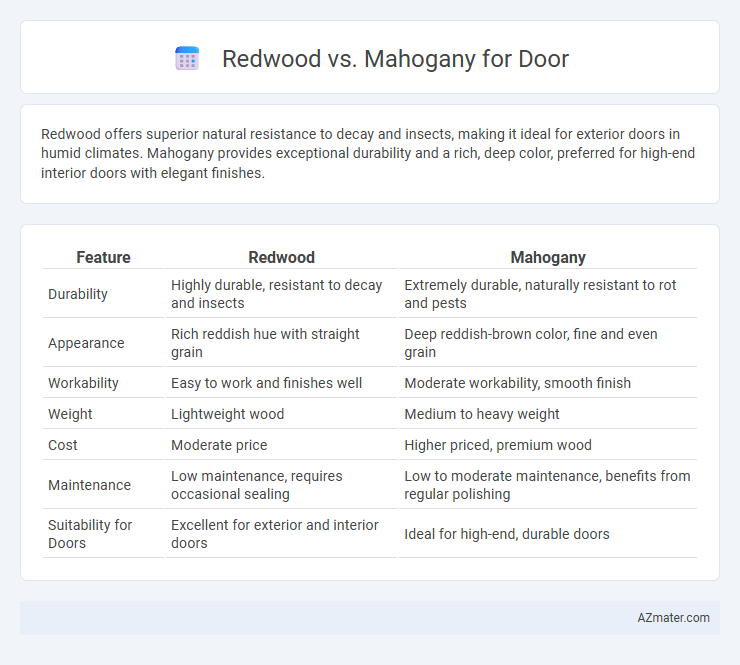Redwood offers superior natural resistance to decay and insects, making it ideal for exterior doors in humid climates. Mahogany provides exceptional durability and a rich, deep color, preferred for high-end interior doors with elegant finishes.
Table of Comparison
| Feature | Redwood | Mahogany |
|---|---|---|
| Durability | Highly durable, resistant to decay and insects | Extremely durable, naturally resistant to rot and pests |
| Appearance | Rich reddish hue with straight grain | Deep reddish-brown color, fine and even grain |
| Workability | Easy to work and finishes well | Moderate workability, smooth finish |
| Weight | Lightweight wood | Medium to heavy weight |
| Cost | Moderate price | Higher priced, premium wood |
| Maintenance | Low maintenance, requires occasional sealing | Low to moderate maintenance, benefits from regular polishing |
| Suitability for Doors | Excellent for exterior and interior doors | Ideal for high-end, durable doors |
Introduction: Redwood vs Mahogany for Doors
Redwood and mahogany are premier hardwoods frequently chosen for doors due to their durability and aesthetic appeal. Redwood offers excellent resistance to decay and insects, making it ideal for exterior doors exposed to harsh weather conditions. Mahogany is prized for its rich color and fine grain, providing a luxurious, classic finish that enhances interior and exterior door designs.
Wood Characteristics: Redwood vs Mahogany
Redwood offers a lightweight structure with moderate hardness and natural resistance to decay and insects, making it ideal for exterior doors exposed to moisture. Mahogany features a dense, fine-grained texture with exceptional durability, stability, and rich reddish-brown color that resists warping and swelling. Both woods provide excellent workability and finishing, but mahogany's superior hardness and tight grain confer enhanced longevity for high-traffic door applications.
Durability and Strength Comparison
Redwood offers excellent durability with natural resistance to decay and insects, making it ideal for exterior doors in humid or wet climates. Mahogany is renowned for its superior strength and dense grain structure, providing enhanced impact resistance and longevity for both interior and exterior applications. While mahogany typically outperforms redwood in hardness tests, redwood's stability and weather resistance ensure long-lasting door performance in varying environmental conditions.
Aesthetic Appeal and Grain Patterns
Redwood doors feature a warm, reddish hue with straight, consistent grain patterns that provide a clean and natural aesthetic appeal, making them ideal for rustic or modern designs. Mahogany doors are prized for their rich, deep reddish-brown color and fine, interlocking grain, resulting in a luxurious and elegant appearance suitable for traditional or high-end interiors. Both woods offer unique visual textures, but mahogany's smoother, more uniform grain often conveys a more polished and sophisticated look compared to redwood's more pronounced and textured grain.
Weather Resistance and Suitability
Redwood offers superior weather resistance for doors due to its natural oils and dense grain structure, making it highly suitable for exterior applications in humid or rainy climates. Mahogany, while also durable, is more prone to swelling and requires regular maintenance to maintain its weather resistance. For long-lasting, low-maintenance exterior doors, redwood is generally preferred for its stability and natural resistance to decay and moisture.
Maintenance Requirements
Redwood doors require low maintenance due to their natural resistance to decay, insects, and moisture, often needing only occasional sealing or staining to maintain appearance. Mahogany doors, while highly durable and resistant to rot, demand more frequent upkeep, including regular refinishing to protect against weathering and color fading. Both woods benefit from periodic inspections to prevent damage, but redwood's inherent resilience generally translates to less intensive maintenance over time.
Cost and Availability
Redwood doors typically cost less than mahogany due to Redwood's faster growth rate and wider availability, making it a more budget-friendly option for homeowners. Mahogany, known for its rich color and durability, commands a higher price because it is a slower-growing hardwood with limited supply, often imported. Availability of Redwood is generally more consistent in North America, while Mahogany can be harder to source sustainably, impacting both cost and delivery times.
Environmental Impact and Sustainability
Redwood and mahogany differ significantly in environmental impact and sustainability when used for doors. Redwood is a fast-growing softwood with better carbon sequestration and is often sourced from certified sustainable forests, reducing deforestation concerns. Mahogany, typically slower-growing and often harvested from tropical rainforests, has higher environmental risks due to illegal logging and habitat destruction, making sustainably sourced mahogany less common and more expensive.
Best Use Cases for Each Wood
Redwood is ideal for exterior doors due to its natural resistance to decay, insects, and moisture, making it perfect for climates with high humidity or frequent rain. Mahogany excels in interior doors where its rich color, fine grain, and durability enhance aesthetic appeal and provide long-lasting performance in controlled environments. Selecting Redwood ensures weather resilience and longevity outdoors, while Mahogany delivers elegance and strength for refined indoor spaces.
Final Verdict: Choosing Redwood or Mahogany for Your Door
Redwood offers exceptional durability and natural resistance to decay, making it ideal for exterior doors exposed to harsh weather. Mahogany provides a rich, elegant appearance with superior stability and fine grain, preferred for high-end, interior doors. Selecting between Redwood and Mahogany depends on whether durability against elements or aesthetic luxury and refined finish is the priority for your door project.

Infographic: Redwood vs Mahogany for Door
 azmater.com
azmater.com